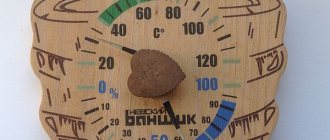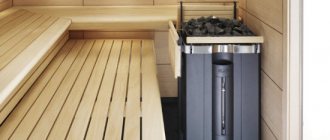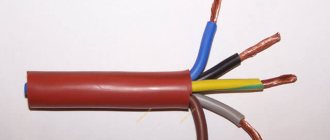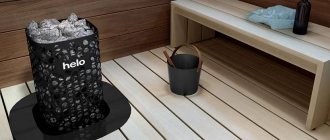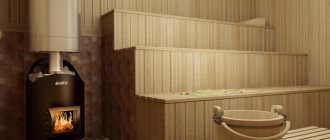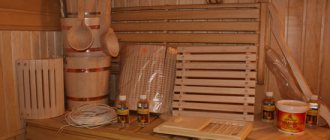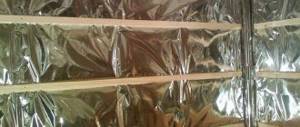What is an electric sauna stove
An electric sauna stove is a special device that generates heat from electric current, that is, converts electrical energy into thermal energy. At the same time, the structure is protected from humidity and water ingress.
According to the design, the heating element is a metal cabin with a spiral of wire with high resistivity. An example of such a wire is nichrome wire, which has a high resistivity with a low temperature coefficient. You can buy X20N80 nichrome wire on the website kmkstal.ru.
Heater device
Distinctive features
The electric furnace is designed for heating premises and organizing hot water supply . The design consists of a double housing, heating elements and thermal insulation.
The main element is the heater. It is installed inside, and a cage for heating the stones is mounted on top. The characteristics of the furnace determine what the maximum temperature will be and how long it will remain.
The outside of the case is equipped with metal plates up to 3.5 mm wide to create ventilation gaps that promote safe cooling of the device.
Metal screens are used for thermal insulation. They protect the wooden surface from overheating and fire.
In private baths, open and closed stoves are installed. Open electric heaters are the most popular because they provide the fastest heating of the steam room and production of steam.
Such devices are equipped with a wire thread, which is mounted in a stand and acts as a heating base..
The heating element allows you to reach the desired temperature in a certain time, and also ensures the stove’s resistance to long-term cyclic loads.
IMPORTANT!
The speed and quality of heating depends on the type of heater.
Types of heating elements:
- Heating element (tubular) . Heats up quickly, but is not the most reliable device. It is the rapid heating rate that shortens the life of the part. The heating element can be enclosed in a stainless steel housing and increase the working life of the device. In this case, the cost of the unit is higher.
- Tape . Heats up quickly. Operates at low temperatures, burning a small amount of oxygen. This creates a comfortable microclimate in the steam room. But this same property prevents the room from quickly heating up.
- Combined . It is a combination of a tubular and tape heating element in one device. This allows you to achieve maximum effect when working. The combination allows you to quickly achieve a high temperature at the initial stage of heating the air. When the tape heater is running, the heating element operates in a gentle mode. This increases the wear resistance of the device. A stove with a combined heating element fails less often, but it also costs more.
Advantages and disadvantages of an electric sauna stove
advantages of an electric sauna stove can be highlighted :
- The main advantage of an electric sauna stove is its ease of installation. To install an electric stove, you do not need a foundation and a chimney, as for a wood-burning stove.
- As a result, the electric furnace does not require a pre-prepared special place in the steam room. The stove is placed in the finished steam room.
- An electric stove does not require special care: there is no need to clean the ash pan, remove ash, or prepare firewood.
- You can't get burned from an electric stove in a sauna, which is also important.
Related articles: Electrical wiring in an apartment
Disadvantages of an electric furnace
The main disadvantage of an electric furnace in a sauna is the mandatory presence of power supply and the additional electrical power generated.
A good sauna requires a good electric heater.
In essence, an electric heater is an electrically heated roaster, made in the form of a small metal box and equipped with a basket for laying stones.
In the upper third of the steel box, heating elements are installed in a metal cage, on top of which rocky ballast is laid.
Often, owners of large baths, in addition to a wood-burning stove, install one or two electric heaters. One stove-stove is placed near the entrance, the second in the center of the steam room. As a result, you can raise the heat in half an hour and dry the bathhouse at the end of the procedures.
Calculation and installation of a stove in a sauna
There are electric ovens on sale that are designed to connect to 220 V and 380 V. The power of the ovens is from 3 kW.
For furnaces with a power of up to 4.5 kW, a 220 V power supply is required. For more powerful furnaces, a 380 V power supply will be required.
calculate the required power of an electric stove using a simple formula: to warm up 1 cubic meter of a wooden sauna you need 0.8 kW of stove power. For ceramic tiles you need 1.3 kW.
To increase safety, it is recommended to protect the walls and floor where the electric furnace is installed with non-combustible materials (ceramic tiles, sheet metal).
Be sure to raise the stove from the floor to the recommended distance. This is necessary for effective ventilation of the steam room.
It is imperative that a ventilation system is installed in the steam room. A hole for air intake is made under the stove 10-15 cm from the floor. The air outlet is made on the opposite wall from the stove, under the ceiling.
The electric oven is connected to a separate group of electrical wiring with protection of this group by a circuit breaker and a residual current device. Two devices can be replaced by one differential circuit breaker.
The rating of protective devices is selected according to the power of the electric furnace.
The furnace power cable is connected to the furnace control panel. This cable is made of copper, double or triple insulated with non-flammable (flame retardant) insulation.
The control panel is installed outside the steam room, usually at the entrance.
From the control panel to the furnace itself, a special cable with rubber heat-resistant insulation or RKGM wires is used.
Related articles: Custom-made living room furniture
Calculation table for installing an electric stove in a sauna
Advantages and disadvantages of 220 V devices
Any 220 V electric sauna stove can operate from a standard power supply. This allows you to make the installation of such a device as fast as possible. In addition, these heaters consume very little energy.
The only disadvantage of such devices is their not very high power, since heaters with a power of more than 8 kW cannot be connected to a 220 Volt network. In most cases, this turns out to be quite enough to quickly warm up a steam room with a volume of up to 12 cubic meters, however, if your sauna has impressive dimensions, you need a 380 V heater. Having trouble choosing the type of device? Use the service of an online consultant or request a call back - we will help you decide!
Electrical wiring for electric furnace
Electrical wiring is carried out to power the electric furnace according to the rules for installing electrical wiring for wet rooms, namely:
The cross-section of the cable cores is selected according to the maximum power of the furnace;
To reduce the cost of electrical wiring, it is permissible to install an electrical box with IP protection from IP=54 a meter from the stove. To the box, make the wiring with a VVGng or NYUM copper cable, and from the box to the stove, make the wiring in metal corrugation or pipes with an expensive heat-resistant cable;
The through passage of cables through the walls is carried out in embedded non-flammable pipes, which are sealed with non-flammable solutions (materials). Electrical and control cables are laid separately.
Electrical wiring in the bathhouse. How to make electrical wiring in a sauna with your own hands.
Did you like the video? Subscribe to our channel!
Sauna is the Finnish name for our bathhouse. In Russia and other countries, any steam room with dry steam is considered a sauna. But this is a mistaken opinion. The Finns don't understand this kind of sauna. However, as a rule, a bathhouse and a sauna are practically twin brothers. Both here and there they wave birch brooms, and here and there they add steam, pouring water from a ladle onto the heater. The usual temperature in a sauna ranges from 70 to 110 degrees. In Finland, there are no less than 2 million saunas per 5 million population. In Russia, saunas are also very popular. Warming up in a sauna leads to an improvement in the functional state of the body's systems and organs, promotes the development of compensatory and protective mechanisms, improves metabolism, calms the nervous system, increases mental activity and activates vigor. This is due to the beneficial effects of sweating and heat on the respiratory, cardiovascular, endocrine and thermoregulatory systems of most people. To prevent a trip to the sauna from being marred by troubles, the electrical wiring in the bathhouse/sauna must be installed very carefully and correctly. To ensure that the electrical wiring in the bathhouse with your own hands is efficient and of high quality, listen to our recommendations. Saunas are fire hazardous objects that contain many harmful factors for electrical wiring, and, accordingly, for the life and health of people, as well as the integrity of the sauna itself. Therefore, if possible, use the help of professionals to install electrical wiring in the sauna. If for some reason you decide that installing electrical wiring in a bathhouse is quite feasible for you, pay close attention to fire safety requirements. Electrical wiring in the bathhouse must be designed taking into account high humidity and high temperature. If your sauna is built of wood, then the installation of wiring in the bath should be of the highest quality and responsible due to the likelihood of fire. In sauna rooms that are not rooms with high temperature and humidity, it is recommended to lay the VVGng-LS cable ( VVGng-LS 3x2.5
– for connecting sockets and cable
VVGng-LS 3x1.5
– for connecting lighting). The insulation of this sauna cable does not support combustion and has a low smoke level during smoldering. Wiring in the bathhouse/sauna is preferably in flame-retardant cable ducts. In those rooms where the temperature rises to high values, you need a cable (wire) that does not collapse at such temperatures. You can install wiring in a bathhouse in a corrugated pipe or cable duct, inside of which single wires of the brands PMTK, PRKA, RKGM or PRKS are located. These wires can easily withstand temperatures of 170°C. Electrical wiring in the bath/sauna should not have metal sheaths or pipes. Naturally, after installation it is necessary to check the sauna cable for the integrity of the insulation. The entire electrical wiring process can be divided into stages: 1. inserting the cable into the sauna/bathhouse 2. installing the panel in the sauna/bathhouse 3. routing the cable from the panelboard in the bathhouse/sauna 4. connecting lamps in the bathhouse/sauna 5. connecting sockets in the bathhouse/sauna 6. connecting an electric furnace in a bathhouse/sauna
Cable entry into the sauna/bath
Our sauna can be located both outside the home and in a residential area. If the sauna is located outside the building, then we will need to lay a power cable to the sauna building from the main distribution board. The simplest and least labor-intensive method is an overhead line. If there is a significant distance between the input panel and the sauna building, additional supports. It is recommended to use a self-supporting insulated self-supporting insulated cable. No cable is required for its installation; it is quite durable, strong and not afraid of ultraviolet radiation. We recommend that the entry into buildings be carried out in an insulating pipe through the wall. The cable can be inserted into the sauna and into the ground, but this is more difficult. Underground entry into a house is much more expensive both in terms of installation and materials. Although it also has its advantages. This is primarily the design of the site itself; there are no hanging wires. This power supply, like all work related to the power supply of a building (house, cottage, cottage, plot), has certain installation rules. When entering underground, the cable is laid in the ground at a depth of 70 cm. For installation, it is customary to use armored cable VBBShV 3×2.5 with copper conductors. It is allowed to lay an unarmored cable at a depth of half a meter if it is reliably protected from damage by pipes, for example VVG 3x2.5. It is advisable to sprinkle fine river sand or soft soil at the bottom of the trench, then place the cable and, after filling 20 cm of soil, mark the location of the cable with signal tape or bricks. This will protect the cable from damage during excavation work on the site. After tape or brick, add soil to ground level. The cable must be introduced into the building in an insulating pipe. Laying cables under building foundations is not permitted. Underground input is preferable from an aesthetic point of view. If the sauna is located in a residential building, then input is much easier. The cable can be inserted into the sauna panel openly in boxes and corrugated tubes, or hidden under a layer of plaster. As mentioned above, a bathhouse is a place with high humidity and elevated temperature. Therefore, do-it-yourself wiring in a bathhouse should be done taking these factors into account.
Installation of a shield in a sauna/bath
The distribution panel in the sauna serves to transfer energy to consumers. Since the entire energy system of the sauna will be powered from the shield, the reliability of operation and health safety will depend on its condition and proper functioning. In order for the electrical wiring in a bathhouse built with your own hands to be durable, great importance must be given to connecting the electrical panel. The location for the shield must be chosen carefully. Firstly, there must be free access to it, which in no case should be cluttered. Secondly, the shield should not be placed in a poorly ventilated place. Thirdly, the shield should not be placed in fire hazardous areas with high temperatures (for example, a steam room). Fourthly, it is desirable that the electrical panel be illuminated by a natural light source, which is important when working with the meter (if it is important to know the amount of energy consumed by the sauna) when the voltage is turned off. Usually the shield is located in the presence of a vestibule in it, or in a rest room. As a rule, the panel consists of input and output circuit breakers and RCDs (residual current devices). The shield is hung in such a way that its upper part is located at a height of 1.4-1.8 m. If the wiring in the bathhouse/sauna is single-phase, the power cable must consist of at least three cores. According to the latest GOST, the phase conductor must be gray, but you can buy a cable from old stocks, where the phase conductor may be of other colors (white, brown). The phase conductor sits on the upper terminal of the input circuit breaker, and from the lower terminal with jumpers it goes to the upper terminals of all outgoing circuit breakers or is routed to the circuit breakers by a more modern distribution method - through distribution busbars. Accordingly, the neutral conductor (usually blue or light blue) sits on the neutral block, and the protective one (usually yellow-green) sits on the protective block or on the welded bolt of the shield itself. The phase conductors of the cables going to the load are connected to the lower contacts of the machines. We carefully lay the input and output cables in the shield and remove them from the shield using a corrugated pipe. Automatic devices and RCDs must be installed depending on the consumed load of the consumer. Now a few words about choosing the cable cross-section. Depending on the wiring diagram in the bathhouse/sauna, you need to select the cable cross-section, for which you need to calculate the approximate load that the wiring in your sauna will carry. If you only have lighting fixtures in the sauna, then the total power will be no more than 1-2 kW. If you need to operate any additional electrical appliances in the sauna, then you should calculate their approximate total power. If you do not have a particularly powerful consumer, such as an electric furnace, then the total power of your sauna will not exceed 5-6 kW. Please note that electrical appliances usually have their power consumption written on them. Depending on the total power received, we select the cable cross-section. It is advisable to take a 20% power reserve. That is, if our total power is, for example, 5 kW, then we must calculate the wiring according to the value 5 * 1.2 = 6 kW. For this power, we will use an input cable with a cross-section of 4 mm2 ( VVGng-LS 3x4
).
There are special tables for selecting the cross section based on the power of consumers. It is advisable to conduct cables leaving for lighting with a wire with a cross-section of 1.5 mm2 ( VVGng-LS 3x1.5
), to a socket group with a cross-section of 2.5 mm2 (VVGng-LS 3x2.5). It is advisable to conduct all wiring with copper.
Based on the total power, we calculate the current that needs to be known to select the input machine. The current is calculated using a formula known from school and is found by dividing our load by the network voltage. In our case, the current is 6000 / 220 = 27 A. The machine should be selected an order of magnitude greater than the obtained current value. You should choose a 32 A machine. Outgoing machines in groups should be selected according to the same principle. It is advisable to sign in the panel which machine is responsible for which group of energy consumer, and it is also desirable that the panel contains a wiring diagram for the bathhouse/sauna. In a sauna, RCDs (residual current devices) must be used. They will help save the lives of you and your loved ones, as well as the sauna itself from fire. To protect against fire, it is necessary to install an RCD with a cut-off current of 100 mA at the input in our panel, and an RCD with a cut-off current of 10 mA at the socket group. We advise you to pay special attention to good fixation of the cores in the terminal block clamps. A bad clamp causes the area to heat up and can cause the contact to burn and the terminal to burn out. Under no circumstances do any work when the wiring in the bathhouse/sauna is live, as this is very dangerous and can result in electric shock. Even qualified electricians rarely work under voltage!
It is prohibited to store foreign objects in the shield, with the exception of the circuit diagram!
Cable routing from the panel in the bathhouse/sauna
It is recommended that the cables extending from the panel be routed in one piece. Wire cross-sections are calculated depending on the expected load. It is recommended to use cables with copper conductors. If the walls of the sauna are wooden, then the electrical wiring in the bathhouse/sauna should be carried out in boxes or corrugated. If the walls are brick, then it is advisable to hide the cables under a layer of plaster. No twists, switches or sockets should be located in rooms with high humidity and high temperature. Thus, switches and sockets must be located in rest rooms or dressing rooms. Accordingly, mounting boxes are also prohibited in these rooms due to a certain likelihood of moisture accumulation with an unnamed short circuit. The latest edition of the PUE generally prohibits any twisting in places indicated by the wiring diagram in the bathhouse/sauna. The PUE obliges the conductors of wires to be connected by welding or soldering, but twisting also has the right to life, subject to strict measures of protection from high temperatures and humidity. It is recommended to use protective grounding in saunas. So, even at the construction stage, it would be useful to use a steel mesh for leveling the potential over the waterproofing under the concrete base. The mesh, naturally, must be connected to the protective circuit. Wires from junction boxes should only go at right angles, this is especially true for hidden wiring. This is necessary to easily locate the cable in the wall. Do not run cables above the stove. The wiring in the bath/sauna should not have metal sheaths or pipes.
Connecting lamps in a bath/sauna
Sauna lights should be selected based on high temperature and high humidity levels. They must be very reliably protected from water in the sauna. Lamps must be waterproof with a protection class of at least IP-44. The lampshades should be made of glass, and the body should preferably be metal. Plastic housing is not recommended due to possible deformation at high temperatures. The iron housings must be connected to the protective conductor of the cable. It is recommended to use lamps with a power limited to 75 W. The wiring diagram in the bathhouse/sauna will tell you where to place the lighting fixtures. Placing luminaires on the ceiling poses a risk. The highest temperature builds up under the ceiling, negatively affecting both the lamp itself and the nearby wooden structures. The placement of lamps on walls, where the temperature is significantly lower, has become widespread. In the steam room and washing room, it is advisable to use low-voltage voltage (12V), for which step-down transformers are used, located outside these rooms. Lamps with fluorescent lamps are prohibited from being installed in saunas. In the rest room or dressing room, you can place lamps with fewer requirements. The regulations prohibit the installation of light switches located directly in steam rooms and washing rooms.
Connecting sockets in the bath/sauna
Considering the aggressive conditions of saunas and baths, significant restrictions are imposed on sockets. Thus, sockets are prohibited from being located in steam rooms and washing rooms. They can only be used in the rest room and dressing room at a height of 90 cm. The protection class of the socket is selected to be at least IP-44. It is advisable to use sockets with covers. Sockets are installed on the walls depending on the wiring diagram in the bathhouse/sauna.
Connecting an electric furnace in a bath/sauna
Electric stoves are a modern version of wood-burning heaters. Electric ovens also heat up quickly, however, their undeniable advantage is their compactness, manufacturability and ease of use. Modern stoves make it possible to set the optimal temperature and do not become clogged with coals and ash. To connect an electric furnace, you need wires that can withstand, firstly, high temperatures (up to 170 °C) and, secondly, high power consumption (4 kW on average), which should be reflected in the wiring diagram in the bathhouse/sauna. Your choice for connecting an electric furnace may be wiring in a corrugated pipe or cable duct, inside of which there are single wires of the brands PMTK, PRKA, RKGM or PRKS. A copper cable for an electric furnace with a cross-section of 3*2.5 mm can withstand about 5 kW of load. In order not to pull an expensive cable to the shield, it is acceptable to stretch the wires of PMTK, PRKA, RKGM or PRKS to a mounting box located outside the zone of high humidity and temperature, and from the box go from the box with a regular cable, for example VVG 3x2.5
to the electrical panel. The PUE recommends concealed installation of electrical wiring in bathhouses, showers and steam rooms. PUE (Electrical Installation Rules) - this can be said to be the “Bible” of an electrician. It is there that all the requirements and standards are described, applying which we will have high-quality and efficient electrical wiring in the bathhouse/sauna. In bathrooms and showers, only electrical equipment that is specifically designed for use in the relevant areas of these premises should be used. The PUE does not allow the installation of plug sockets in bathrooms, steam rooms and soap rooms of saunas and baths. Any plug sockets and switches must be located at a distance of more than 60 cm from the shower door. In steam rooms, PUE insists on using wiring that can withstand high temperatures (up to 180°C). The PUE strongly recommends that all equipment not built into the electric heater be placed outside the sauna. The PUE insists on the presence of a temperature limiter in the steam room, which, when reaching 140°C, will disconnect the electric furnace from the voltage. Wiring in a bathhouse with your own hands is quite feasible if you use high-quality installation and high-quality electrical equipment, which is the key to your safety!
Advantages of electric heaters offered by us
In addition to the possibility of use both in a sauna and in a Russian bath, and low energy consumption, each electric sauna stove presented in our catalog has the following advantages:
- Simple and reliable design
- High-quality durable materials and the highest accuracy of assembly
- Stylish appearance
- Long-term quality guarantee
- Great price
Order a reliable and modern electric heater from us right now!
Elektrokamenka: reviews
Gvozdiy Alexander Alekseevich, Riga:
To make a heater, it is better to take not stainless steel, but medical metal, the one that is used for making sterile portable tool boxes. This is an alloy based on nickel and copper, does not oxidize, heats up in just a few minutes, and can withstand any steam, even the hottest. Only the mesh needs to be placed inside so that the stones do not scratch the walls. I had a purchased electric heater in my bathhouse, it took half an hour to heat up, and it smelled like burnt brake pads.
Vitaly Kuznetsov, Zelenograd:
An electric heater with a steam generator must be raised to a height of at least a meter above the bathhouse floor. It doesn't have much power, and by the time the steam room warms up, you'll freeze. And it’s better to brew boiling water in advance, rather than torment the electrical wiring and heaters. The thing is not bad, but it requires skill. You can buy and install it, at least for the fact that the stones are not covered with soot, there is no bitter smell of scale in the bathhouse, like with a wood-burning heater.
Recommended Posts
How to choose the entrance door to a bathhouse
Do-it-yourself bathhouse
Wooden font for a bath
How to get rid of ants and bark beetles in a bathhouse
Closed sauna heater
Building a bathhouse with your own hands
What rooms are 380 V stoves intended for?
Each 380 V electric sauna stove is an extremely powerful device with the highest performance. Any of the devices presented in this section of our catalog can quickly warm up even the most spacious room.
All of our ovens are energy efficient, but if you use 380V appliances, your electricity costs will still be higher. In addition, to use such a heater you will need a three-phase network - it can be installed very quickly, but certain time costs cannot be avoided. Therefore, if your steam room is not too large, perhaps you should purchase a 220 V stove.
If you cannot decide on the choice of heater, contact our employees for a free consultation via online chat - we will tell you the best option!

